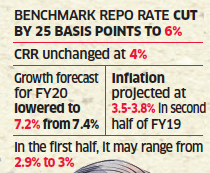7667766266
enquiry@shankarias.in
Why in news?
The Reserve Bank of India recently cut the repo rate by 25 basis points to 6%, in its recent bi-monthly meeting.
What are the highlights?

What are the likely implications?
Why is the downward revision of GDP growth?
What is the inflation outlook?
Source: Indian Express, The Hindu
Author: Shankar Civil Service Coaching Center Bangaluru
Visit for Daily Current Affairs on Indian Economy